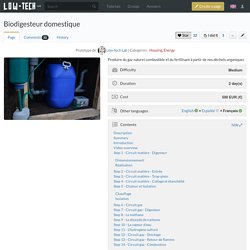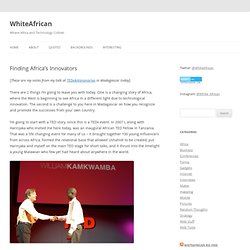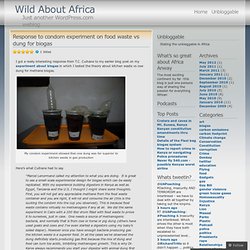

Biodigesteur domestique - Low-tech Lab. Prototype de Low-tech Lab | Categories : Housing, Energy Low-tech Lab.

Youtube.com/redirect?redir_token=QUFFLUhqblc5cC1zdGVDSEliMVZ3NDNCaEZFWVh6R1BNZ3xBQ3Jtc0ttOGdnQUl6NFpTZGlLQ0l1YnVGc1NGdGtFd25IZjM3UWFZUEVPREVGdnhuLXd2djNDWmJ5VzAxMVBHVWt4MFVrbVUxQ2dlUGRBNjdhdjMxNk5TOFgyTHN5RHBhLUthOEEzMmlsY0kxdkNtX25nczNUYw%3D%3D&q=http%3A. Sans titre. Selon l’Agence de l’environnement et de la maîtrise de l’énergie (Ademe), la France comptait 514 sites de méthanisation début 2017.

Ce nombre, encore modeste, ne cesse de croître, l’État ayant récemment pris plusieurs dispositions pour soutenir la valorisation du biogaz émis par ces installations. Grow Heathrow: practical resistance against climate change. By Steve Rushton, all photos by Fanny Malinen.

Grow Heathrow is resisting the expansion of the airport. Meanwhile the transition town is also flourishing providing solutions towards the world’s energy and food problems. It is a working example, applying horizontal community organisation using consensus, amongst many other visions, plans and projects. But to keep focused, this article will explore some practical tips and ideas growing out of Heathrow. Grow Heathrow has transformed an ex-market garden, which it squatted in 2010. Stop the Press: whilst this article was written Grow Heathrow has been in court. Progress now! Wind and solar power Installed for over a year and a half, Grow Heathrow’s wind turbine was made on site, including casting the magnets. One point for anyone thinking of installing solar panels: consider what you need the electricity for. Eco-shower Local organic food and foraging If you know your shit, you can save energy.
Bus - Toilettes - Methaniseur - Générateur pour évennements. Resolviendo los problemas del biodigestor « EspAfriGadget. Pensabais que debido a la gran cantidad de estiércol de vaca disponible en las zonas rurales de África, el biogás sería un gran éxito, ¿verdad?

Pues bien, en realidad es relativamente desconocido. Los principales motivos son los materiales, los costes y la complicada tecnología. La gente de estas zonas utiliza carbón o madera en sus necesidades domésticas. Recoger leña no sólo es un trabajo duro y sucio, sino también insalubre y dañino para el medio ambiente. Pero como es gratis… Finding Africa’s Innovators. [These are my notes from my talk at TEDxAntananarivo in Madagascar today] There are 2 things I’m going to leave you with today.

One is a changing story of Africa, where the West is beginning to see Africa in a different light due to technological innovation. The second is a challenge to you here in Madagascar on how you recognize and promote the successes from your own country. I’m going to start with a TED story, since this is a TEDx event. In 2007 I, along with Harinjaka who invited me here today, was an inaugural African TED Fellow in Tanzania. Another Malawian TED Fellow, Soyapi Mumba, introduced me to someone I had written about but never met: William Kamkwamba. Rural Africans And Biogas For Home Use.
Photo by: showmeone on Flickr This is actually a pretty cool idea.

Biogas analysis in my kitchen « Wild About Africa. I know I’m onto a great thing by running my stoves on biogas, it’s cheap, easy and good for the environment.

Here are some facts about biogas from cow dung: Cow dung gas is 55-65% methane, 30-35% carbon dioxide, with some hydrogen, nitrogen and other traces. One cow produces approximately 36 – 68 kg of dung per day! About one cubic meter of biogas can be generated from 16 kg of cow manure at around 28°C. This is enough gas to cook for a few hours. Biogas Project - Phase 01. Response to condom experiment on food waste vs dung for biogas « Wild About Africa. I got a really interesting response from T.C.

Culhane to my earlier blog post on my experiment about biogas in which I tested the theory about kitchen waste vs cow dung for methane biogas. My condom experiment showed that cow dung was far superior to kitchen waste in gas production Here’s what Culhane had to say “Marcel Lenormand called my attention to what you are doing. It is great to see a small-scale experimental design for biogas which can be easily replicated. Well, Mr. Gobar Gas — Tip of My Brain. Technology Network. ARTI Biogas Plant: A compact digester for producing biogas from food waste.
ARTI has developed a compact biogas plant which uses waste food rather than dung/manure as feedstock, to supply biogas for cooking.

The plant is sufficiently compact to be used by urban households, and about 2000 are currently in use – both in urban and rural households in Maharashtra. A few have been installed in other parts of India and even elsewhere in the world. The design and development of this simple, yet powerful technology for the people, has won ARTI the Ashden Award for Sustainable Energy 2006 in the Food Security category.
This makes ARTI the only organization in the world to win the prestigious Ashden Award twice. ARTI won its first Ashden Award in 2002 for its chain of technologies for converting agricultural waste into charcoal, and using this as a clean domestic fuel. The impending scarcity of petroleum threatens the world’s fuel supply. To know how this technology works, click here. Benefits. Gobar Gas. (Abridged version1) Smart Moms raise smart kids Brunei, Afghanistan, Nepal, Cambodia, Laos, VietnamPublished: 08 June 2010 Michael Yon A Gurkha Idea Among the more interesting coalition forces fighting in Afghanistan are the legendary Nepalese Gurkhas.

The insights of a Gurkha veteran named Lalit, whom I met in the jungles of Borneo, at a British Army man-tracking school, were particularly valuable. Blog Archive » Poop piki piki for my biogas system. This gadget was created to solve a real problem with biogas – getting the dung to the system quickly and efficiently. Motorbikes are the taxi’s of Africa so why not? Before I tell you about the above gadget I just want to remind you about the problems we have been having to solve to get the biogas to work at home. Installing biogas at home has a real experience in afrigadget – we have figured out by trial and error how to get the gas under pressure – At first we tried using water pressure, but when we stepped back and looked at it we realized that it really wasn’t simple or appropriate for bush applications ..
In fact, all we needed to do was to put pressure on the bags. The pressure wasn’t enough to run the stove until we modified the stove jets by enlarging them slightly. The problem I face is common to many folks around here, we rent houses but we don’t have livestock. We tested it with a human load to ensure it is balanced … each bucket weighs about 50 kg. Blog Archive » Solving the flexible biogas digester problems. You’d think that given the amount of cow dung available around rural Africa that biogas would be a big hit right? Well, its actually relatively unknown. The main reason is materials, coast and complicated technology. People in these areas use charcoal or wood for their domestic cooking needs – its not only dirty hard work to collect firewood, but it’s unhealthy and damages the environment. But, it’s free … We believe that biogas from cow dung holds huge promise for rural and urban areas as a cheap source of energy that can be turned into domestic use or even business anywhere in rural Kenya….eg. pasturizing milk, making yoghurt, running fridges, generators, hammer mills for grinding corn, cooking, baking, heating water, running machines… and reducing your carbon footprint.
Blog Archive » Solving the flexible biogas digester problems.